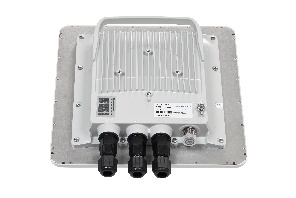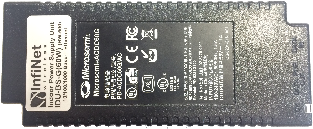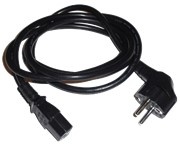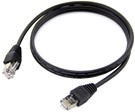| Metadata (Metadata Plugin) |
|---|
|
Laboratory pre-configurationdfgdfgdfgdfgdfgconfiguration |
In order to initially setup an operational point-to-point link you must run the procedure described please follow the steps below.
...
- Use InfiNet Wireless link planner tool InfiPLANNER to estimate link performance and required configuration in terms of antennas, channel width, Tx power, etc.
- Determine line of sight conditions and obstacles along the path
- Perform spectrum analysis and figure out spectrum occupation and available channels
...
...
Pre-configure
...
units in the lab
The equipment list required for lab configuration
| Center |
|---|
| Scroll Title |
|---|
| title | Table - The equipment necessary for initial configuration |
|---|
| | Component | Description |
|---|
|
| | - 2 x Indoor power supply IDU-BS-G(60W)
| |
| | | | - 4 x Ethernet cablespatch cords
|
|
|
In the lab and later on site perform connect the connections as devices as indicated below:
- Connect laptop to the IDU port labeled as "IN" with an Ethernet cable.
Use another Ethernet cable to connect "GE0" port at the ODU to the IDU port labeled as "OUT".
- Use power cord to connect the IDU to using AC mains.
| Center |
|---|
| Scroll Title |
|---|
| title | Figure- Connection Scheme |
|---|
| 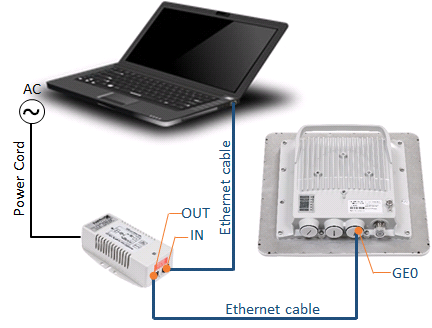
|
|
| Warning |
|---|
|
Before supplying power to the Um models an external antenna or RF terminators with 50 Ohms resistance must be connected to both N-type connectors. During laboratory testing, it is allowed to directly connect two devices with RF cables without antennas with the mandatory use of attenuators with attenuation of at least 40 dB for each polarization. Switching off/on the attenuators and RF cables should only be performed when the devices are in the off state. In case the antenna, attenuator or terminator is connected to only one N-type connector do not switch on the device. PLEASE NOTE THAT VIOLATION OF THE ABOVE REQUIREMENTS VOIDS THE WARRANTY. |
After the physical connections are completed, perform settings of configure each unit as described below.
Units settings can be performed via:
...
Settings via web interface
| Anchor |
|---|
| Settings via web interface |
|---|
| Settings via web interface |
|---|
|
| Step 1 |
|---|
Access the unit to the default IP address 10.10.10.1 with mask 255.255.255.0 via web browser. Make sure that the Ethernet port of the Laptop has an IP address assigned from the same |
network class subnetwork as the one for the unit (for example, set 10.10.10.50 with mask 255.255.255.0). |
| Step 2 |
|---|
Use any letters or numbers for initial authentication, for example: - User name: "login".
- Password: "password".
|
After the initial login to the units, it is recommended to change the user and password to more secure permanent valuesMake sure to set strong passwords before running the units in production. |
|
| Step 3 |
|---|
Enter unitWeb GUI. Initially the status of the radio link is DOWN like below. | Center |
|---|
| Scroll Title |
|---|
| title | Figure - Initial link status |
|---|
| 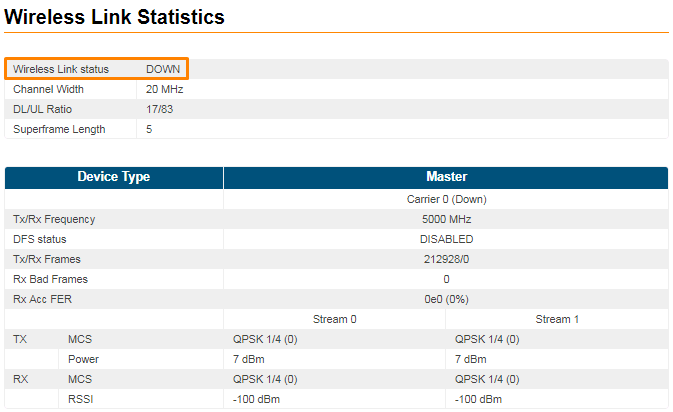 Image Modified Image Modified |
|
|
| Step 4 |
|---|
|
newest available latest stable firmware version.
|
| Step 5 |
|---|
Perform radio settings. Go to the "Radio" section and set the following parameters: - Node Type (one unit must be set to Master and the other one to Slave).
- Link ID.
- Channel Width.
- Frame period.
- Max Distance.
- Center Frequency.
- Maximal Transmit Power
|
.| Note |
|---|
|
Make sure that both units are configured with maximum Tx power| Note |
|---|
| The detailed description for each radio setting can be found in the section "Radio". |
| Warning |
|---|
| Please note that the following parameters must have the same values at each of the two units in the PtP link. Otherwise the wireless link |
|
between them won’t be established: - Center Frequency
- Channel Width
- Frame Period
- Max Distance
- Short Cyclic Prefix
- Link ID
|
|
| Step 6 |
|---|
Save the configuration, reboot both units and check if they link is up |
after reboot. The link status should be UP and the radio statistics should indicate the capabilities and quality of the link. | Center |
|---|
| Scroll Title |
|---|
| title | Figure - Link UP status |
|---|
| 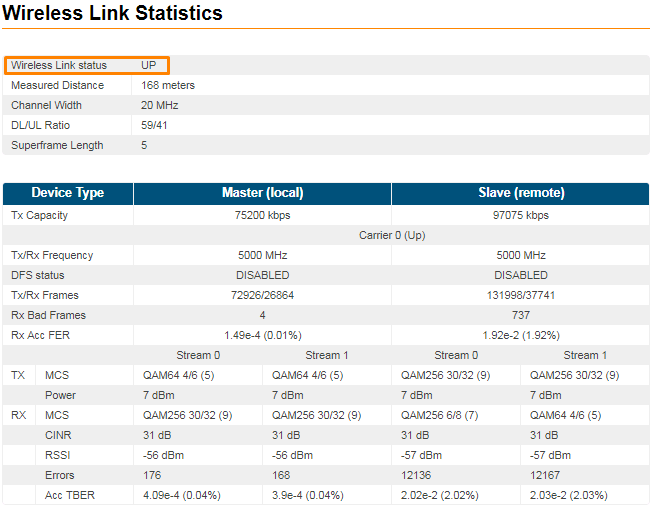 Image Modified Image Modified
|
|
|
Settings via CLI
| Anchor |
|---|
| Settings via CLI |
|---|
| Settings via CLI |
|---|
|
| Step 1 |
|---|
CLI is available via telnet: "cmd> telnet 10.10.10.1" or use any suitable telnet client such as Putty. | Center |
|---|
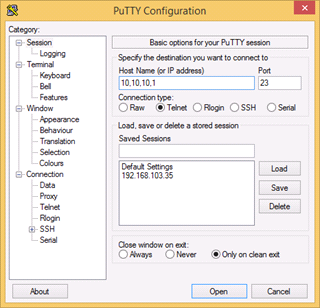 Image Modified Image Modified
|
|
| Step 2 |
|---|
Use any letters or numbers for initial authentication, for example: - User name: "login".
- Password: "password".
|
After the initial login to the units, it is recommended to change the user and password to more secure permanent values
Make sure to set strong passwords before running the units in production. |
|
| Step 3 |
|---|
Chech Check the firmware version and upgrade the units to the |
newest available latest stable firmware version. You can check firmware version via command: | Code Block |
|---|
| language | powershell |
|---|
| theme | Emacs |
|---|
| xginfo version |
Compare current version of the unit with version on official |
InfiNet ftpH12 of a newer version is available |
it is recommended to upgrade the firmware |
| Step 4 |
|---|
Configure radio parameters. | Center |
|---|
| Parameter | Command | Value (example) |
|---|
| Node Type | xg -type | master (slave) | | Link ID | xg -cell-id | 1 | | Channel Width | xg -channel-width | 40 | | Frame period | xg -sframelen | 5 | | Max Distance | xg -max-distance | 1 | Downlink Center Frequency
| xg -freq-dl | 4960 | Uplink Center Frequency
| xg -freq-ul | 5010 | Maximal Transmit Power
| xg -txpwr | 10 |
|
|
| Note |
|---|
|
Make sure that both units are configured with maximum Tx power.| Warning |
|---|
| Please note that the following parameters must |
|
have the same values at each of the two units in the PtP linkmatch at both units. Otherwise the wireless link |
|
between them won’t be established: - Center Frequency
- Channel Width
- Frame Period
- Max Distance
- Short Cyclic Prefix
- Link ID
|
|
synchronize units settings, copy from one unit and paste to another the "Peer exported config" line shown in the same settings to the another unit you should use the following command output "xg config -peer-exported" |
|
command output. See the configuration example below:. Execute these commands in CLI of the another unit. |
|
javaDJango | #Peer exported config:
xg -v3-start
xg -v3 a01b833402f59907abdcb812d5de20fd.Ko7ClHTRVps/8oyNjnucBcSqUlcCJbOae9Kf4OZ
xg -v3 zRU7tYm1REMTUyHWYTaGGuuooDp2DWkcxyFGLmEb5yx45wFImL5Nx72XK6bnl9AzRdZjWVSN
xg -v3 xCrliSUfn7JZazn1yTEKE90fKLIK/HKNJXYN7vg4lEocgBWguYdFc/u8fEwENtJYBSKNGbu3
xg -v3 HQ0HvIdTqAwOz5vXM89CkhL5ZZmDuYN3FFSo6wV+h//zBuSfuJ5QVb6fv2Do6tPIE4kuZSsB
xg -v3 UXLavUriPtSlRxzIYUO7+9XSMggomrf7NZtM37PxQkUYIZ116K3++w5HPVXXq8Po7xVmotnq
xg -v3 px1uDbYtSjs2O9yx6h6Z0HGp8GLAEY7Ka5ZRoyAvyfA73pobYrEhzZ+hdwWnDDJYM3DmAhuW
xg -v3 yAUgtVHJ4hC9u6BP5IAlQXsm5QSbuRwihWdmrwiThwSGmXiZWCXOmxzg1IA==
xg -v3-end |
|
|
| Step 5 |
|---|
Save configuration. | Code Block |
|---|
| language | powershell |
|---|
| theme | Emacs |
|---|
| config save |
|
| Step 6 |
|---|
Restart the unit. | Code Block |
|---|
| language | powershell |
|---|
| theme | Emacs |
|---|
| restart yes |
|
| Step 7 |
|---|
|
establishmentstatus. | Code Block |
|---|
| language | powershell |
|---|
| theme | Emacs |
|---|
| Sys log show | grep UP |
In case of success configuration: | Code Block |
|---|
| language | powershell |
|---|
| theme | Emacs |
|---|
| [XG]: changed state UP->DOWN |
|
Perform Initial Antenna Alignment
| Step 1 |
|---|
Install both units on the pole and direct them at each other (more detailed information about units installation and antenna alignment is described in the section "Units Installing"). |
| Step 2 |
|---|
Turn them on and make sure that the units subsystems are working properly. This can be done by LED indication. | Center |
|---|
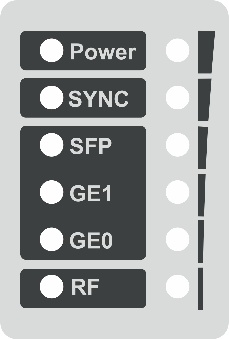
|
| Center |
|---|
| Scroll Title |
|---|
| title | Table - Indicator Panel Description |
|---|
| | LED | Normal state | Function |
|---|
| Power | On | On - power is applied to the device Off - no power is applied or improper power source | | SYNC | On | TDD-synchronization | | SFP | On | Ethernet link | | GE1 | On | Ethernet link | | GE0 | On | Ethernet link | | RF | On | RF link. Blinking while establishing RF link |
|
|
|
| Step 3 |
|---|
Perform coarse alignment using built-in signal strength indicators. | Note |
|---|
| The The more indicators are on, the better wireless connection is established. The blinking indicator means an intermediate state. The more often the indicator blinks the higher level connection is established. |
|
| Step 4 |
|---|
Perform fine alignment using the "Alignment tool" available in the Web interface or "xginfo stat" output in the CLI. Try to maximize CINR and RSSI readings. Please follow the detailed indications from section Antenna alignment for a proper antenna alignment. |
...
